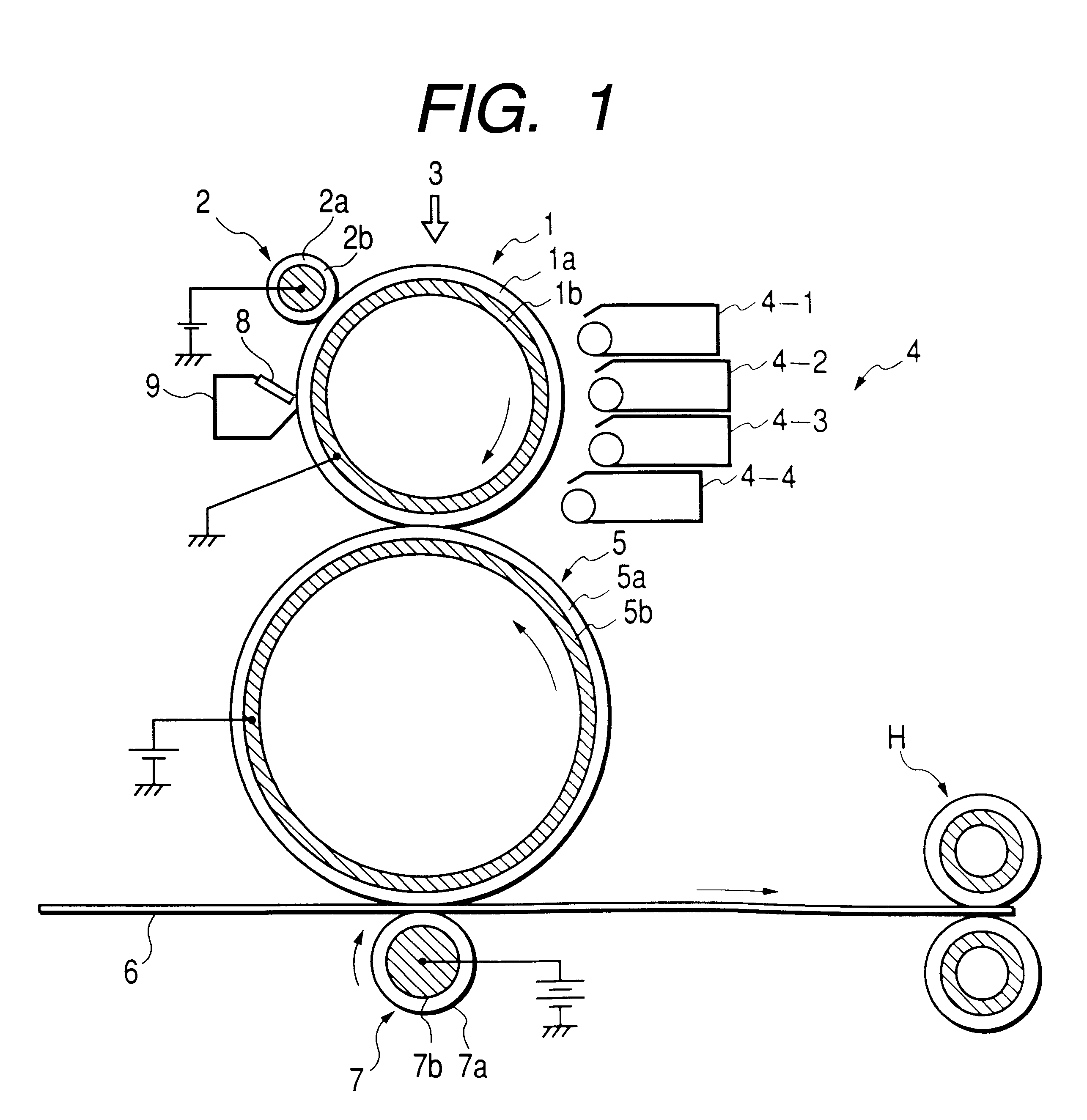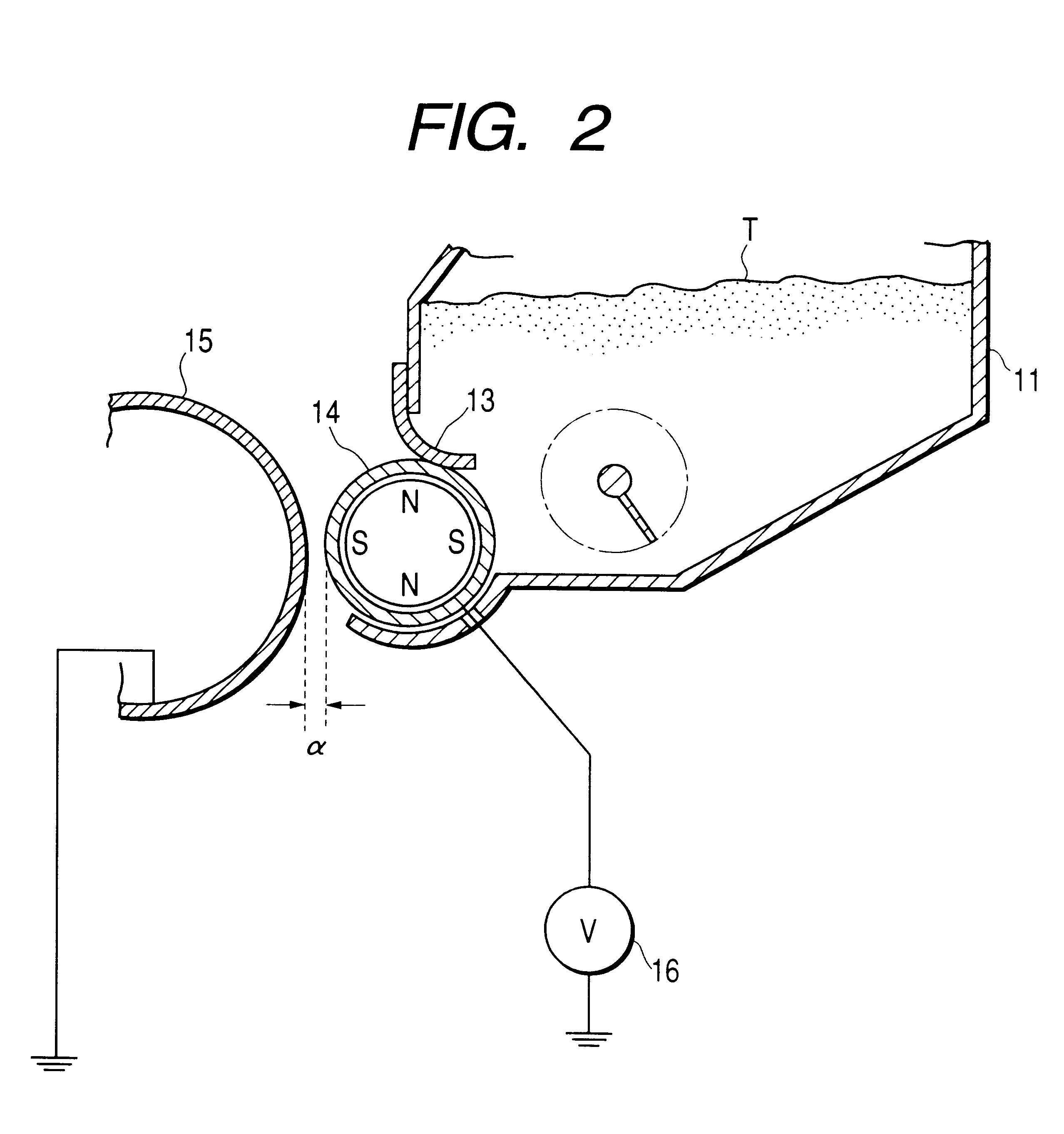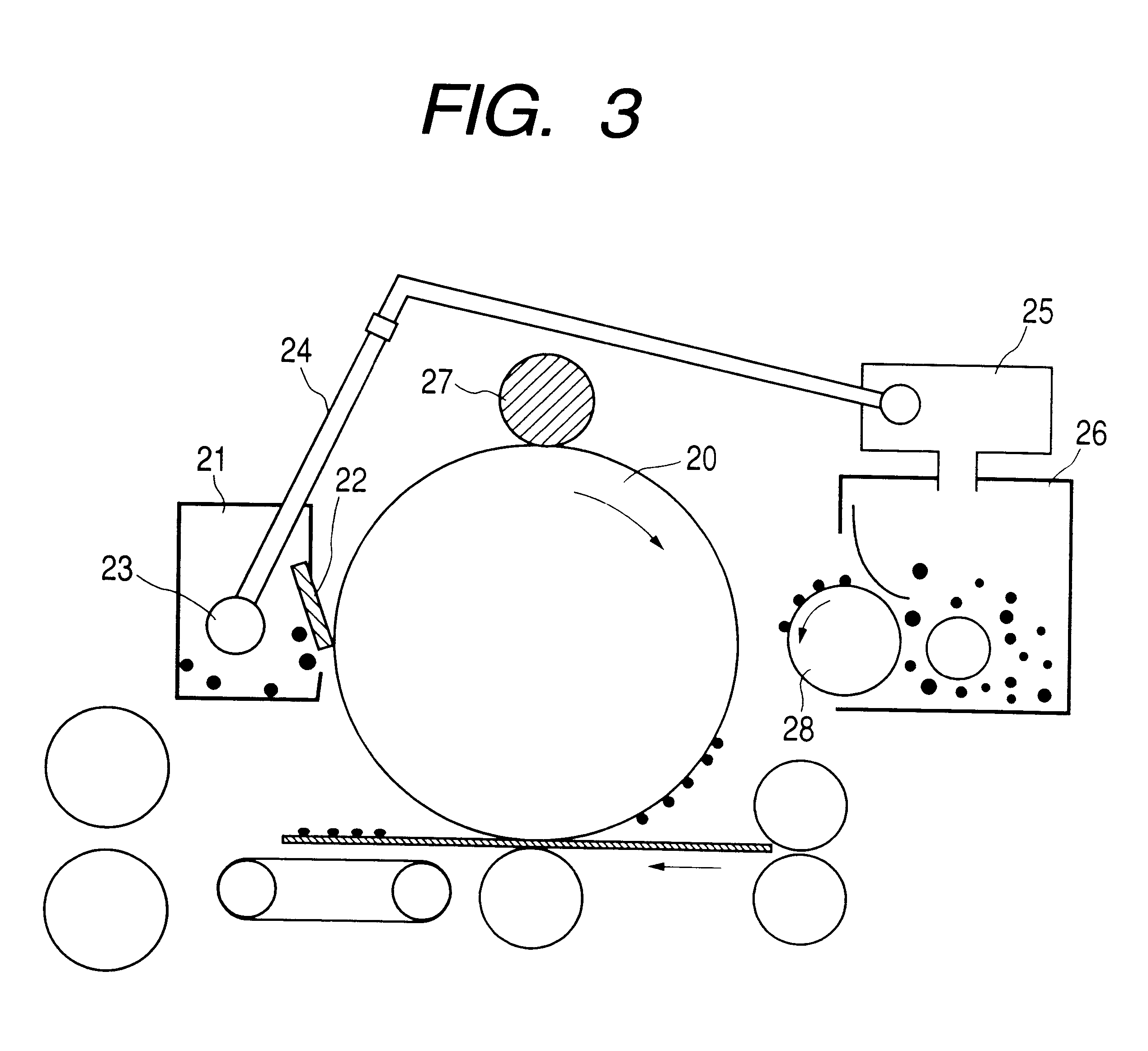These methods are all superior methods which can relatively stably obtain good images, but on the other hand have problems inherent in the two
component type developers, such that the carrier may: deteriorate and the
mixing ratio between the toner and the carrier may change.
On the other hand, since the magnetic toner is conductive, there is the problem that it is difficult to electrostatically transfer the developed images from the electrostatic latent image bearing member to a final transfer-receiving medium such as plain paper.
Such a method, however, has the problems that the development speed is substantially low and the density of developed images is not well attained.
Such methods, however, have the problems that the triboelectric charging tends to be insufficient because of a small number of contact times between the magnetic toner particles and the friction member and the magnetic toner particles charged tend to
agglomerate on the sleeve because of the
Coulomb force increasing between the magnetic toner particles and the sleeve.
Stated in detail, in the
jumping development making use of a magnetic toner containing a conventional magnetic material, as a result of repetition of a developing step (e.g.,
copying) over a long period of time, the fluidity of the developer containing the magnetic toner may lower to make it impossible to achieve sufficient triboelectric charging, so that the charging tends to become non-uniform, and
fog tends to occur in an environment of low temperature and low
humidity, tending to cause problems on images.
In the magnetic iron
oxide particles thereby obtained, the
silicon element is distributed in a large quantity inside the magnetic iron
oxide particles because of the use of the
silicate for the controlling of particle
diameter and the
silicon element is less present on the surfaces of the magnetic iron
oxide particles, so that the improvement in fluidity of the magnetic toner tends to become insufficient.
Hence, there is the problem that the
triiron tetraoxide particle surfaces are weak to mechanical shock such as friction.
Hence the magnetic toner containing such magnetic iron oxide particles tends to cause a considerable lowering of triboelectric charging performance after it has been left in an environment of
high humidity for a long period of time.
Hence, it becomes difficult to uniformly disperse the
powder in the toner composition, causing faulty charging of toner and a phenomenon of come-off of
powder from toner particles.
Also, in the above method, the treating agent reacts in the reaction solution in so low an efficiency that the methods have poor economical advantages and also any unreacted treating agent having not participated in the particle
surface coating of the magnetic
powder may localize on the particles to cause a difficulty in its matching for image forming methods.
An attempt to increase OH groups on the particle surfaces of the magnetic powder or to enhance treatment strength in order to improve the anchoring rate may cause a decrease in the content of FeO in the magnetic powder, resulting in a decrease in blackness.
This method, however, because of a weak anchoring power of the oxide particles, requires a restriction of kneading strength when toners are produced, or has a problem on the running performance of toner.
Since, however, a plurality of toner images must be exactly superimposed on the transfer-receiving medium at its preset position, even a little difference in registration makes it difficult to form a high-quality image in a good reproducibility, and the transport mechanism for transfer-receiving mediums must be made complicated to cause problems of a low reliability and an increase in the number of parts.
As for the method in which the transfer-receiving medium is attracted and wound on the surface of a transfer member, the transfer-receiving medium may cause a faulty
close contact at its rear end because of a
high stiffness of the transfer-receiving medium, consequently tending to cause faulty images due to faulty transfer undesirably.
Similar faulty images tend to occur also in small-sized sheets of paper.
In addition, application of such a
high voltage tends to cause faulty transfer because of leakage of transfer electric currents as the transfer-receiving medium comes to have a lower resistance, in an environment of
high humidity having a
relative humidity above 60% RH.
In an environment of
high humidity having a
relative humidity of 40% RH or below on the other hand, it may also tend to cause faulty transfer due to uneven resistance of the transfer-receiving medium.
In particular, when a full-color
copying machine or full-color printer in which a plurality of toner images are transferred after development is used, the quantity of toner on the photosensitive member is larger than the case of monochromatic black toners used in black and white
copying machines or printers and it is difficult to improve
transfer efficiency when conventional toners are merely used.
Also when usual toners are used, the melt-adhesion of toner or filming tends to occur on the surface of the photosensitive member or on the surface of the intermediate transfer member because of a
shear force or frictional force acting between the photosensitive member or intermediate transfer member and the cleaning member and / or between the photosensitive member and the intermediate transfer member, so that the
transfer efficiency tends to lower or, in the formation of a full-
color image, the toner images corresponding to the four colors can not be uniformly transferred.
Thus, problems tend to occur in respect of uneven colors and
color balance.
Especially when the magnetic toner containing a magnetic powder is used as a black toner, the above problems tend to occur.
If the silicon element is in a content less than 0.4% by weight and the
atomic ratio of Fe / Si is greater than 4.0, it follows that the silicon element is present in a large quantity in the insides of the magnetic iron oxide particles, so that the improvement on the magnetic toner, in particular, the improvement in fluidity of the magnetic toner can not be so much effective.
Also, if the magnetic iron oxide particles having the silicon element in such a state is surface-treated, the treating agent may insufficiently cover the particle surfaces.
Meanwhile, if the silicon element in the magnetic iron oxide particles is in a content more than 2.0% by weight and the
atomic ratio of Fe / Si is greater than 4.0, the addition of silicon element can be made effective with difficulty to affect the magnetic properties of the magnetic iron oxide particles, undesirably.
If on the other hand the atomic ratio of Fe / Si is less than 1.0, the charging performance in an environment of high
humidity tends to lower and also the dispersibility of magnetic iron oxide in the binder resin may lower to tend to cause a lowering of developing performance and running performance of the magnetic toner.
This method is not preferable because cake-like agglomerates tend to be formed in the course of
dehydration or
drying to make it difficult for the particles to be uniformly dispersed in toner materials.
If the magnetic iron oxide particles have a
bulk density less than 0.8 g / cm.sup.3, the coat treatment with the surface modifying agent tends to be insufficient and the physical properties of their blending with other toner materials when the toner is produced tends to be adversely affected and the dispersibility of the magnetic iron oxide particles tends to lower.
On the other hand, if it is more than 2.0% by weight, the environmental properties of the magnetic toner, in particular, the charging performance in an environment of high
humidity tends to lower.
If it is more than 10.0, the charging performance can not be made stable.
If the magnetic iron oxide particles have a BET specific surface area larger than 15.0 m.sup.2 / g, the
moisture adsorptivity of the magnetic iron oxide particles may increase to adversely affect the
moisture absorption and charging performance of the magnetic toner containing the magnetic iron oxide particles.
Hence, in an environment of low humidity, the magnetic toner containing such magnetic iron oxide particles tends to cause charge-up and tends to cause a decrease in
image density.
If the total pore volume exceeds 15.0.times.10.sup.-3 ml / g, the magnetic iron oxide particles may come off the magnetic toner particles because of their weak adhesion to the binder resin, so that the magnetic toner tends to be adversely affected to cause, e.g., a decrease in
image density.
Hence, in an environment of high humidity, the magnetic toner containing such magnetic iron oxide particles tends to adsorb
moisture when left in such environment, to tend to cause a decrease in charge quantity, resulting in a decrease in
image density.
Small pores make it difficult for adsorbed moisture to be desorbed.
If in the magnetic iron oxide particles the total specific surface area of pores with pore diameters smaller than 20 angstroms exceeds the total specific surface area of pores with pore diameters not smaller than 20 angstroms, it follows that the particles have more adsorption sites from which the adsorbed moisture is desorbed with difficulty, so that the magnetic toner containing such magnetic iron oxide particles tends to cause a great lowering of its charging performance especially when left for a long term in an environment of high humidity, also making it difficult to restore the charging performance.
Thus, in the toner containing such magnetic iron oxide particles, the charging performance tends may be adversely affected especially in an environment of high humidity.
On the other hand, if the shape factor SF-1 is more than 160, the toner particles may be excessively shapeless, so that the toner may have a broad charge distribution and also the toner particle surfaces tend to be polished, to cause a decrease in image density and an image
fog.
Also when usual amorphous or shapeless toners are used, the
shear force or frictional force acting between the electrostatic latent image bearing member and the cleaning member, between the intermediate transfer member and the cleaning member and / or between the electrostatic latent image bearing member and the. intermediate transfer member may cause melt-adhesion of toner or filming to to cause a difficulty in the matching for image forming apparatus.
Hence, the final
transfer efficiency may greatly lower to tend to cause a lowering of toner utilization efficiency and also cause a problem on the matching for image forming apparatus as stated above.
If the maximum endothermic peak is lower than 40.degree. C., the
wax component may have a weak self-cohesive force, resulting in weak high-temperature anti-offset properties and also an excessively high gloss.
If on the other hand the maximum endothermic peak is higher than 130.degree. C., fixing temperature may become higher undesirably and also it is difficult to appropriately smoothen the fixed-image surface.
Hence, especially when used in color toners, such a compound is not preferable because of a lowering of
color mixing performance.
In the case of a magnetic toner having a weight average particle
diameter smaller than 3.5 .mu.m, untransferred magnetic toner may remain on the electrostatic latent image bearing member or intermediate transfer member in a large quantity because of a lowering of transfer efficiency, and also such a toner is not preferable because it may cause uneven images due to
fog and faulty transfer.
If the theoretical
glass transition temperature is lower than 40.degree. C., problems may arise in respect of storage stability or running stability of the toner.
Especially in the case of color toners used to form full-color images, the
color mixing performance of the respective color toners at the time of fixing may lower, resulting in a poor color reproducibility, and also the transparency of OHP images may lower.
Thus, such temperatures are not preferable.
The
emulsion polymerization as typified by
soap-free polymerization is effective because the toner can have a relatively uniform
particle size distribution, but the emulsifier and polymerization initiator used may remain on the toner particle surfaces to tend to cause a lowering of environmental properties in some cases.
If the toner carrying member has a
surface roughness Ra larger than 1.5, the toner layer on the toner carrying member can be made thin with difficulty and the charging performance of the magnetic toner may lower, thus no improvement in
image quality can be expected.
Also, when images requiring a large quantity of toner over a
wide area are developed, the quantity of toner fed to the electrostatic latent image tends to become short to tend to result in an insufficient image density.
If on the other hand the former is more than 3.0 times the latter, not only various problems caused by excessive charging of toner but also the deterioration of toner that is due to mechanical stress or the sticking of toner to the toner carrying member tend to occur.
On the other hand, the toner tends to be so excessively charged that it tends to melt-adhere to the toner carrying member or elastic blade.
If the touch pressure is smaller than 0.1 kg / m, it is difficult to uniformly coat the toner, resulting in a broad charge quantity distribution of the toner to cause fog or black spots around line images.
If the touch pressure is greater than 25 kg / m, a great pressure is applied to the toner to cause deterioration of the toner and occurrence of agglomeration of the toner, thus such a pressure is not preferable, and also not preferable because a great torque is required in order to drive the toner carrying member.
 Login to View More
Login to View More 


